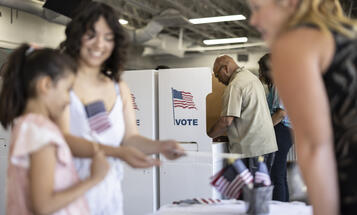
Introducing The Voter Inclusion Principle: Expanding The Right To Vote
Could it really be that the tide is turning in favor of American voters? According to the New York Times this week, the ruling in Pennsylvania that voters will not have to present government issued photo ID to vote is “the latest and most significant in a series of legal victories for those opposed to laws that they charge would limit access to polls in this presidential election. With only a month left until Election Day, disputes around the country over new voter ID requirements, early voting, provisional ballots and registration drives are looking far less significant.”
It is true that courts have been striking down Republican efforts to restrict voting among certain demographic groups. Yet by no means is the fight over. There are plenty of restrictive laws that recently have been put on the books that must be overcome between now and November 7, and beyond. For example, even though the Pennsylvania ID law won’t apply to this election, the decision anticipates it will be in effect in 2013. Nonetheless, the recent court decisions do give the parties and candidates in particular an opportunity to reflect on what they are doing, and potentially take their tactics in another direction: a positive one that encourages voter participation rather than tries to suppress it.
The political parties can, for this and future elections, embrace what I call in my recent book, The Politics of Vote Suppression,the Voter Inclusion Principle (VIP). In general, the VIP posits that election law should be used to encourage and boost voter participation, not make it unnecessarily difficult, or serve as a deterrent to any citizen’s participation.
VIP in a nutshell is this: using election laws and procedures to increase the participation of legal, eligible voters is inherently legitimate—even if it boosts participation just on one side—as long as no strong countervailing value would be demonstrably and specifically jeopardized. Indeed, it must be considered appropriate for the parties and candidates to use all legal means to increase participation among their supporters: if the parties and candidates do not do this vital work, civic participation will not reach its full potential. Election reforms passed in a vacuum—without any of the relevant players seizing upon and using them proactively—while necessary and helpful, will not take our country far enough in increasing voter participation. At the same time, using the law to suppress voting is never legitimate.
A great example of the VIP being followed, with positive results, is North Carolina in 2008. In North Carolina, the Obama campaign and nonpartisan voter organizations used early voting and a newly passed same-day registration law to push turnout to historic highs, especially in the African American community. Same-day registration—allowing voters to register and vote at the same time during the early voting period—was a major focus of the Democratic ground game. In this way, North Carolina increased its voter participation more than any other state in the nation in 2008, going from 64 percent turnout in the previous presidential election to 70 percent turnout. Most notably, the rate of African American voting increased from 59 percent to 72 percent from 2004 to 2008. Some 2.4 million people voted early in North Carolina in 2008.
A quarter of a million voters took advantage of same-day registration, and nearly half of them were first-time voters in their jurisdiction. A total of 21 percent of the voting-age population in North Carolina is African American, yet these voters made up 35 percent of same-day voter registrants. More than half of African Americans voters used either early voting or the combination of same-day registration and early voting.
Both parties could be doing this in 2012. They seem to have started to catch on with respect to early voting and, as a result, early voting for the first time could start to reach its full potential as a means for increasing participation. Indeed, media reports indicate that both campaigns are going to great lengths to get people who don’t often vote to register and vote early so they can focus on other groups of voters when Election Day comes nearer. This is an enormously encouraging development for those who value wider democratic participation.
There are other ways the campaigns can use election reforms to increase votes for their candidates rather than suppress those for the other side, such as Same Day Registration. As of this year, eleven states have laws allowing voters to register and vote on the same day. The states that have this process consistently have the highest turnout rates in the country.
While the parties may be focused on turning out registered voters to vote early now, they could take this progress even further by focusing on those voters who are not registered but, closer to Election Day, could be interested in voting. This would be a way to expand the pool of potential voters rather than diminish it. And each party can focus these efforts on groups that they believe through their research are their natural constituents. It’s a win-win for the candidates, the voters, and the democratic system.
Another opportunity exists with respect to overseas voters. Under the MOVE Act, all overseas and military voters should have received their ballots by now. In some states, those registered voters overseas are indicated on the publicly available voter registration list, along with their party affiliation. It is also public information as to who has requested an absentee ballot from overseas. As a result, the parties could be engaging in the same types of get-out-the-vote efforts for overseas voters as they do for absentee voters in the United States. For example, the parties could, at a minimum, target their most loyal members whom they can identify as currently residing overseas and send them e-mail and mail reminders, information on how to effectively cast a ballot, identify the deadline dates for their state, and even provide information on getting the federal postcard application that they can use to register and request an absentee ballot if they have not already done so.
The parties could also work to increase the turnout of naturalized citizens and others who may not feel able or comfortable navigating the voting process in English, who have usually lagged behind other groups in voter participation. The parties can ensure that Latino, Asian, and Native American voters get the assistance they need to fully participate in our democracy. In fact, the parties should be insisting on strong enforcement of existing mandates regarding language assistance in areas of the countries where many non-native speakers live.
In addition, as web use becomes increasingly prevalent across a wide spectrum of groups, the parties should have voting information materials and registration forms in alternative languages on all of their own websites and advocate that state websites do so as well. All states should be strongly encouraged to provide web-based information and materials, such as registration forms, in alternative languages known to be commonly used in that state. This is an easy, inexpensive way to get more information and easier access to limited-English speakers.
Over the next several weeks, the American people will continue to need to educate themselves and their neighbors about the ways in which voting may be problematic and how intentional efforts to suppress the vote can be overcome. As voting now begins, we also must be especially wary of individuals and groups showing up at the polling place and challenging voters’ eligibility or harassing and intimidating them.
Our democracy has served us well, and has been marked by a nearly continual expansion of the franchise of voting. Recent attempts to roll back that progress are a stain on a national treasure, and should not be allowed to continue. The courts have, for the moment, recognized these partisan tactics as unjust. We must continue the pushback toward a more positive vision of democracy now—with both parties seeking more voters rather than suppressing them.


